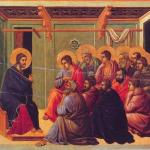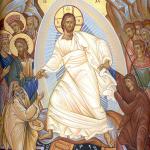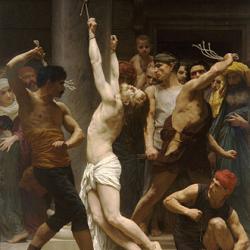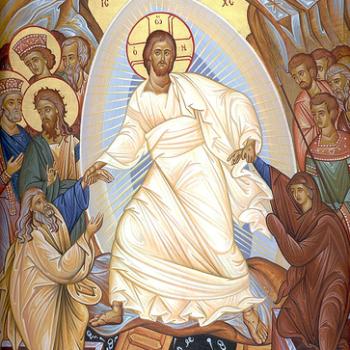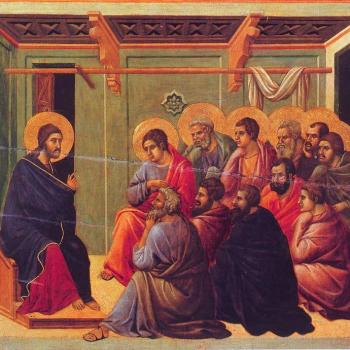For Your Edification on this Holy Good Friday
Here is a passage from
What Jesus Saw from the Cross (1930, 1948)
by A. G. Sertillanges
That book is in the public domain according to Internet Archive.
What kind of tree was privileged to provide the wood upon which the world’s most precious fruit should hang? It is not certain. In all probability it was a coniferous tree. A legend fixes a valley to the southwest of the city,
belonging to the Greek monastery of the Holy Cross, as the place where the tree was cut; but so many childish legends flourish in that place that it is difficult to take this seriously. As a matter of fact, it is hard to see how
anyone can be certain on this point. A praetorium contained a whole collection of crosses, but they bore no labels to indicate the place from which they came.
In fact, the Liturgy is better inspired when it abstracts from the material origin of a wood which is so permeated with spiritual significance:
Faithful Cross, O tree all beauteous,
Tree all peerless and divine,
Not a grove on earth can show us
Such a flower and leaf as thine.
Sweet the nails and sweet the wood
Laden with so sweet a load.
And there are other ways of expressing the same sentiment as in this song with the same title.
These tender mystical reflections have a greater charm than any stories of Lot planting a tree, and of the Queen of Sheba finding the tree used to make a threshold in the temple of Solomon, and similar fantasies.
When we speak of the Cross as a piece of wood, we do not think of its growth nor of its situation. Its situation is the universe; its growth dates from the “Sixth Day,” unless you would rather say that it exists and grows
in the heart of the Christian when he unites himself to his divine Master. The Cross is necessary for the salvation of the world: happy the land, happy the soul willing to pay the price of it
The first spasms shake the body already mercilessly torn by the scourging and by a night of torment; the victim has been raised roughly upon His gibbet; the blood flows in thin streams from His hands and feet, oozes from
His forehead, and stripes His breast and members along the marks of the lashes. The cruelly strained position allows no movement but the soul is unfettered, and the great shudders that rack the body leave the mind in full
possession of its powers.
There is still a little more of this great life to be lived, a life which in the narrow confines of Judea embraces all the world: a cry or two more, a few more words of sovereign power, and one more lament that asks compassion
of earth and Heaven: of earth, to recompense it with mercy to us, of Heaven, to grant us its blessings. And through it all is that glance which sees beyond all things, that glance which we shall follow as far as our sight
can reach. But it goes infinitely beyond our vision, for it passes through the visible and invisible worlds and penetrates to their source, to the very depths of God
After the Cross has been erected, Calvary stands still for a moment, shocked into immobility by the spectacle of supreme pain. The inevitable reaction affects even the executioners. But above all it affects the Sufferer.
After the terrible jolt with which the Cross fell into the rocky hole, sending a shudder through the beam and through the members of the victim, the Crucified welcomes as a sort of relief the dull, continuous agony which now
ensues and will only later reach its paroxysm.
The noises of the city make themselves heard fitfully through this furtive silence. The cries of donkey drivers fill the void left by the silenced blasphemers. Camels pass with majestic tread, carrying their loads back to
Jaffa or Damascus. Off in the distance the wind raises arid clouds from the sandhills. Moab is shrouded in a mist of mauve. The fig trees give forth their honeyed scent. At the foot of the Cross the red blossoms slowly
increase and multiply. The hand of death, for a moment hesitating, relaxes its pitiless hold on the breast of Jesus.
And then, the Master opens His eyes.
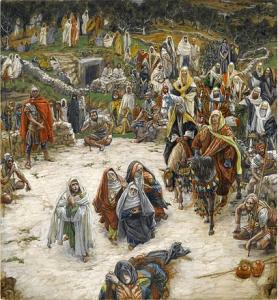
Read More Meditations In
Were You There When They Crucified My Lord? | Mark Wilson
Expanding on the theme from this passage, one of the best theological books I have every read was a children’s book called ‘The Proud Tree’ (1981) by Luane Roche. I used to read it to my CCD kids when I taught catechism. It tells the story of the crucifixion from the viewpoint of Rex, the tree that became the cross Jesus carried to Calvary. This is the part I am talking about when I think of deep theology put simply for children (and adults to read).
As if in answer to his wondering, Rex heard Jesus speak. What he said sent shivers up and down Rex’s trunk.
“Father, forgive them. They do not know what they are doing.” Jesus voice was gentle and pleading. Rex was stunned!
“Don’t know what they’re doing? Forgive them? Are you going mad with Your pain? Nobody forgives people like this. Even trees don’t forgive such terrible cruelty. All creation knows we have to hate our enemies! Especially when they beat us and put us to death.”
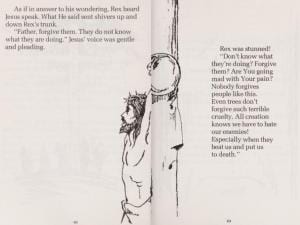
Rex kept trying to reason with Jesus. After all, the Man on the Cross had every reason in the world to be angry.
“Listen, nobody ever forgives people like this,” he said again.
“Nobody, of course, except maybe G-O-D!” Suddenly Rex realized who this Man was. He began to feel weak. Rex began to stammer.
“Who-who did He call Father? I have heard talk of a Father in heaven-and a Son. Could this really be God? Can it be that this is Truly the Father’s Son?”
The very thought filled Rex with wonder.
“He-He’s touching me. He carried me. He is nailed to me. Why would God want to be so close to Me?”
Read it at Open Library or Kindle.


